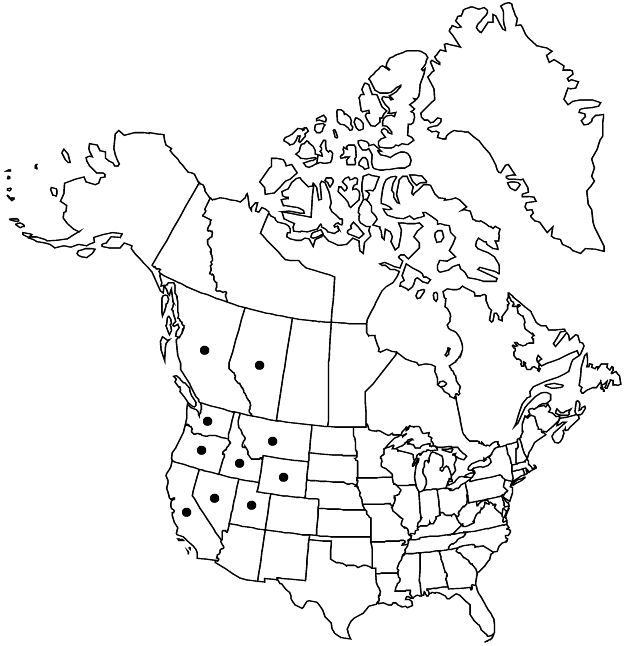Drymocallis pseudorupestris
Monogr. N. Amer. Potentilleae, 194. 1898.
Caudex branches elongate. Stems openly tufted to loosely spaced, (0.3–) 0.6–4 dm; base 1–3 mm diam., ± densely septate-glandular. Leaves glabrate or sparsely to ± densely hairy; basal (2–) 3–16 cm, leaflet pairs (2–) 3–4 (–5); terminal leaflet broadly obovate-cuneate to flabellate, 0.2–3 (–4) × 0.5–3 cm, teeth single or double, 2–15 per side, apex usually rounded to truncate, sometimes obtuse; cauline 0–2, reduced, leaflet pairs 2–3. Inflorescences 2–40-flowered, not or ± leafy, open, 1/6–3/4 (–4/5) of stem, ± wide, branch angles (10–) 20–40 (–50) °. Pedicels 3–20 (proximal to 40) mm, not or sparsely to moderately short-hairy, predominantly septate-glandular. Flowers opening widely; epicalyx bractlets linear to elliptic, 2–6 × 1–2 mm; sepals spreading, 4–7 (–9) mm, apex acute to obtuse, apiculate; petals overlapping or not, spreading, cream-white to pale-yellow (red-tinged in var. crumiana), narrowly to broadly obovate, 4–12 × 3–11 mm, longer than sepals; filaments 1–4 mm, anthers 0.7–1.2 mm; styles thickened, 1–1.5 mm. Achenes light-brown, 1 mm.
Distribution

Alta., B.C., Calif., Idaho, Mont., Nev., Oreg., Utah, Wash., Wyo.
Discussion
Varieties 3 (3 in the flora).
Drymocallis pseudorupestris occurs from Alberta and Washington to California and Utah, mostly in montane habitats; it is the species most often associated with rocky habitats, including talus slopes, for which its relatively elongate caudex branches are an obvious adaptation. Vestiture is dominated by abundant septate glands on stems and in the inflorescences. Except for var. pseudorupestris, which occurs only in the northeastern part of the species range, plants are relatively short, usually less than 2.5 dm. Three intergrading varieties accommodate the extremes at the northeastern and southern ends of the range.
Selected References
None.
Lower Taxa
Key
| 1 | Stems (1–)2–4 dm, bases (1.5–)2–3 mm diam.; basal leaves (4–)7–16 cm; terminal leaflets (1–)2–3(–4) cm, teeth usually double, (5–)8–15 per side; flowers (5–)10–40; petals 6–12 × 5–11 mm, widely overlapping; filaments 2–4 mm. | Drymocallis pseudorupestris var. pseudorupestris |
| 1 | Stems (0.3–)0.6–2.5 dm, bases 1–2(–3) mm diam.; basal leaves (2–)3–9(–15) cm; terminal leaflets 0.2–2(–4) cm, teeth single or ± double, 2–8(–12) per side; flowers 2–12(–20); petals 4–8(–9) × 3–6(–8) mm, not or ± overlapping; filaments 1–2.5(–3) mm | > 2 |
| 2 | Basal leaves: leaflet pairs (2–)3(–4); hypanthia and sepals not bristly or bristles less than 1 mm; short hairs sparse to moderately abundant on stems and pedicels (sometimes absent); styles usually golden brown, rarely reddish. | Drymocallis pseudorupestris var. saxicola |
| 2 | Basal leaves: leaflet pairs 3–4(–5); hypanthia and sepals prominently bristly, bristles 1–1.5 mm; short hairs absent or sparse on stems and pedicels; styles usually dark red, rarely golden brown. | Drymocallis pseudorupestris var. crumiana |
"thin" is not a number."wide" is not a number."dm" is not declared as a valid unit of measurement for this property."dm" is not declared as a valid unit of measurement for this property.